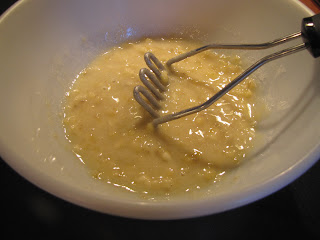This is one recipe, however, that I am willing to play around with: turkey chili. I don't mess with the essential ingredients, but I will add things liberally as necessary. It's a good way to use up those random vegetables that are lying around the kitchen. I tend to have a lot of those. I make a recipe that involves half a red onion and then never find a use for the other half. Or, even worse, I get a tomato and only use a tiny bit. I don't eat tomatoes. Jeff loves them, but he's not home all day like I am so he forgets about what might be lurking at the back of the fridge. A recipe like this, though, allows you to just toss them in. Today, my extras included the last two tomatoes left over from my garden (yes, I know it's after Thanksgiving - they took forever to turn red and I never found a use for them!) and some frozen butternut squash cubes.
Butternut squash cubes? I know you're thinking that sounds weird. I got this from one of the food blogs I follow (I don't remember which). The woman suggested this as a way to slip nutritious vegetables past unsuspecting children. I boiled large chunks of butternut squash until they were soft, pureed them in a blender (with a tiny bit of water for smoothness) and then poured them into ice cube trays. Days later (when I finally got around to it), I turned them out of the trays and put them all in a bit ziplock bag. Now I have them to use all winter, slipping them into sauces and soups almost like vitamin supplements. As of yet, I have only added them to tomato-based sauces. I haven't noticed the flavor at all, although I do think my chili tasted a bit sweeter than usual. It takes an already healthy meal and makes it even healthier!
The greatest thing about this chili, apart from its versatility, is the turkey. I use 94% fat free ground turkey breast. That 6% and 2 tbsp of olive oil is the entire fat content. The rest is just meat, veggies and seasoning. I thought it was a good choice for post-Thanksgiving. I want to try and eat lighter this week.
My favorite way to eat this chili is over white rice with sour cream and Mexican (or sharp cheddar) cheese on top. My second favorite way is with tortilla chips, almost as a dip. Jeff has even rolled it up into a (very messy) sort of wrap using a flour tortilla. Since this recipe makes a pretty healthy amount of chili, you'll have a chance to try it a variety of ways before it runs out.
Turkey Chili
2 tbsp olive oil (I generally use light for cooking)
1 lb ground turkey breast (the original recipe calls for 1 1/4 lbs, but my grocery store only sells it in 1 lb packages)
3 tbsp chili powder
1 tbsp grill seasoning
1 tbsp ground cumin
2 tbsp Worcestershire sauce
dash hot sauce
1 yellow onion, diced into 1" pieces
2 bell peppers, diced into 1" pieces (I like to use two different-colored peppers. A 1" dice leaves fairly large chunks - if that's not to your taste, you can chop them smaller.)
1/2 bottle of beer (I don't drink, so I don't have a favorite beer to recommend, but I generally go for a medium or light amber variety.)
28 oz can tomato puree
1/2 c BBQ sauce
1 c frozen corn
sour cream and shredded cheese to garnish
Heat a large pot over medium-high heat. Add the oil and heat up. Add the ground turkey. Season with chili, grill seasoning, cumin, Worcestershire sauce and hot sauce. Break up the meat into small crumbles (I chop it with a wooden spoon as I stir). Brown the meat for about 5 minutes.
Add the peppers and onion and cook for another 10 minutes.
Add the beer to deglaze (this may not be necessary - I use a nonstick pot, so very little sticks). Add the tomato puree, BBQ sauce and corn. Stir well to mix. Bring the chili to a bubble and simmer for at least 10 minutes more. (This is a Rachel Ray recipe, so she says this to keep the total time at 30 minutes. In my experience, the longer you cook the chili, the better the flavors blend. I would definitely let it simmer longer if you have the time.)
Serve topped with sour cream and cheese!












































